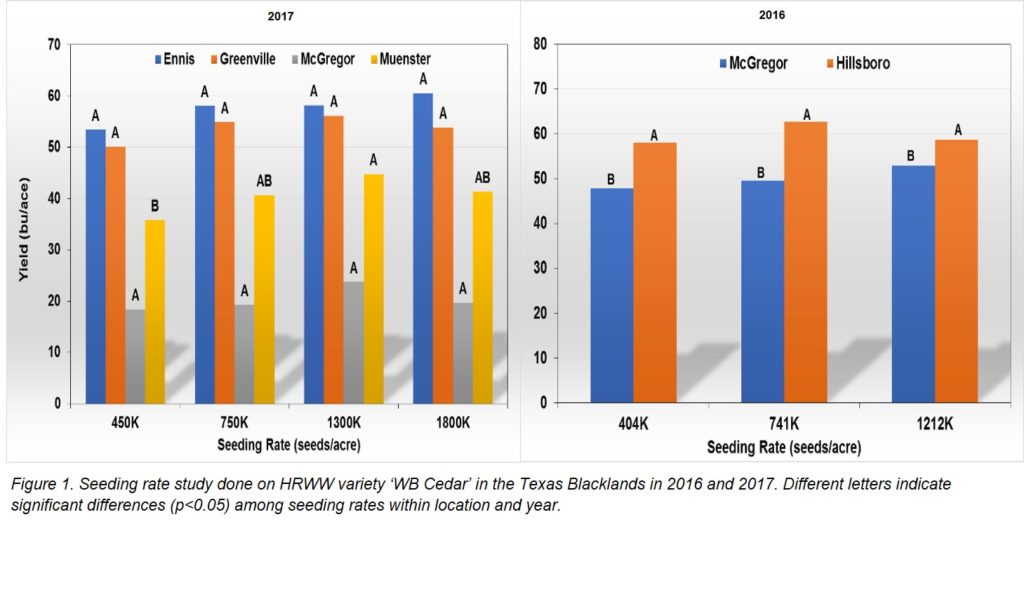by Dr. Clark Neely, Statewide Small Grains and Oilseed Extension Specialist, College Station, TX
Dr. Josh McGinty, Regional Extension Agronomist, Corpus Christi, TX
Planting season is quickly approaching for producers planting wheat for grain this fall. As everyone knows, wheat prices are low and turning a profit will be difficult. Finding ways to cut costs and not influence yield or returns will be important. One potential option is cutting back seeding rates. Over the past two years, seeding rate treatments have been incorporated into variety trials across the Blacklands and South Texas regions. Trials were harvested at seven locations in 2017 and two locations in 2016 with yields ranging from 18 to 70 bushels across locations and treatments. In the Blacklands, treatments ranged from 404K seeds/acre (30 lb/a) to 1.2 million seeds/acre (90 lb/a) in 2016 and from 450K seeds/acre (33 lb/a) to 1.8 million seeds/acre (134 lb/a) in 2017. A significant yield response was only detected at Muenster, where the 450K treatment was significantly lower than all other rates. No other individual location produced significant differences among seeding rates. When averaged across locations, 405K reduced yield 13% in 2017. In 2016, no differences were detected and 741K was numerically the highest when averaged across both locations.
In South Texas, ‘TAM 401’ was evaluated in 2017 under different seeding rates at Uvalde and Wharton. Again, no differences were detected at either site. A hard red spring wheat (HRSW) ‘Expresso’ was sown at five different rates from 500K through 1.5 million seeds/acre. At Castroville and Wharton, yield increased 11.4 bu/a (52%) on average from 500K to 750K before levelling off. At Uvalde, a strong and positive linear relationship occurred between yield and seeding rate. Yield increased 18 bu/a (26%) from 750K to 1.8 million seeds/a.
Summary
Based on this information, producers planting winter wheat in the Blacklands or South Texas are not likely to see yield advantages above 750,000 seeds/a (roughly equivalent to 50 lb/a depending on seed size) if planted on time. Assuming certified seed cost $37/bu and seed size is ~16,000 seed/lb, a producer could potentially generate $21/acre in cost savings by reducing seeding rate from 1.3 million seed/a (~90 lb/a) to 750,000 seed/a. Certain varieties have different tillering abilities, and those with lower tillering capabilities may still benefit from higher seeding rates. ‘WB Cedar’ is considered a high tillering variety. Producers should consider planting conditions as well when deciding on planting rate. Poor seedbed environments resulting in poor seed-soil contact due to cloddiness or excessive residue may benefit from higher seeding rates, as well as too much or too little moisture at planting. Also, if planting is significantly delayed, then increasing seeding rate is recommended to compensate for decreased tillering in the fall. The HRSW planted at South Texas locations followed a similar pattern as the HRWW in two out of three locations which were lower yielding environments. A strong linear trend at Uvalde suggests that spring wheats may benefit from higher seeding rates under higher yielding, high input environments. Spring wheat trials will be repeated in 2018 to confirm these findings. Response to seeding rate of a lower tillering winter wheat, ‘TAM 304’, will also be evaluated in the upcoming year.
For more information on stand establishment of small grains please visit: http://varietytesting.tamu.edu/files/wheat/otherpublications/Stand%20Establishment%20of%20Small%20Grains%20-%20Miller%201999.pdf.

